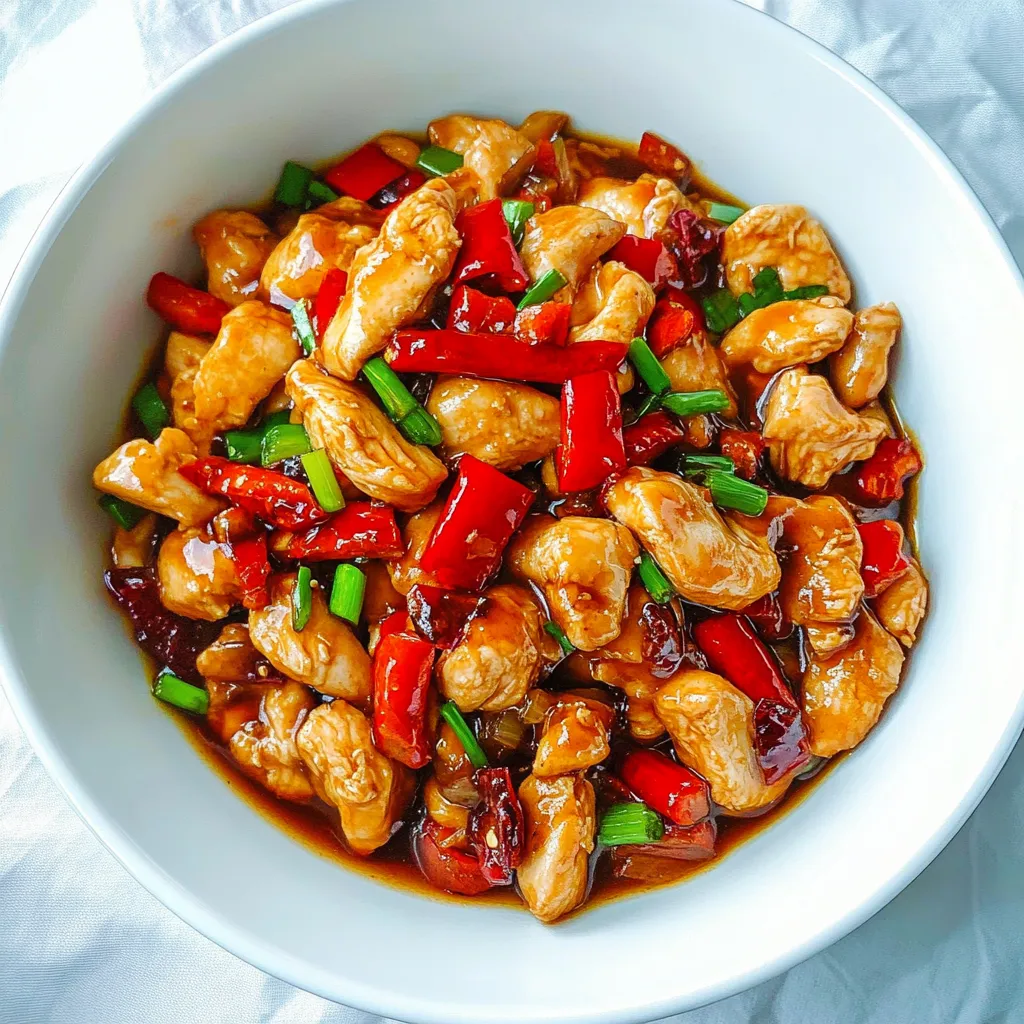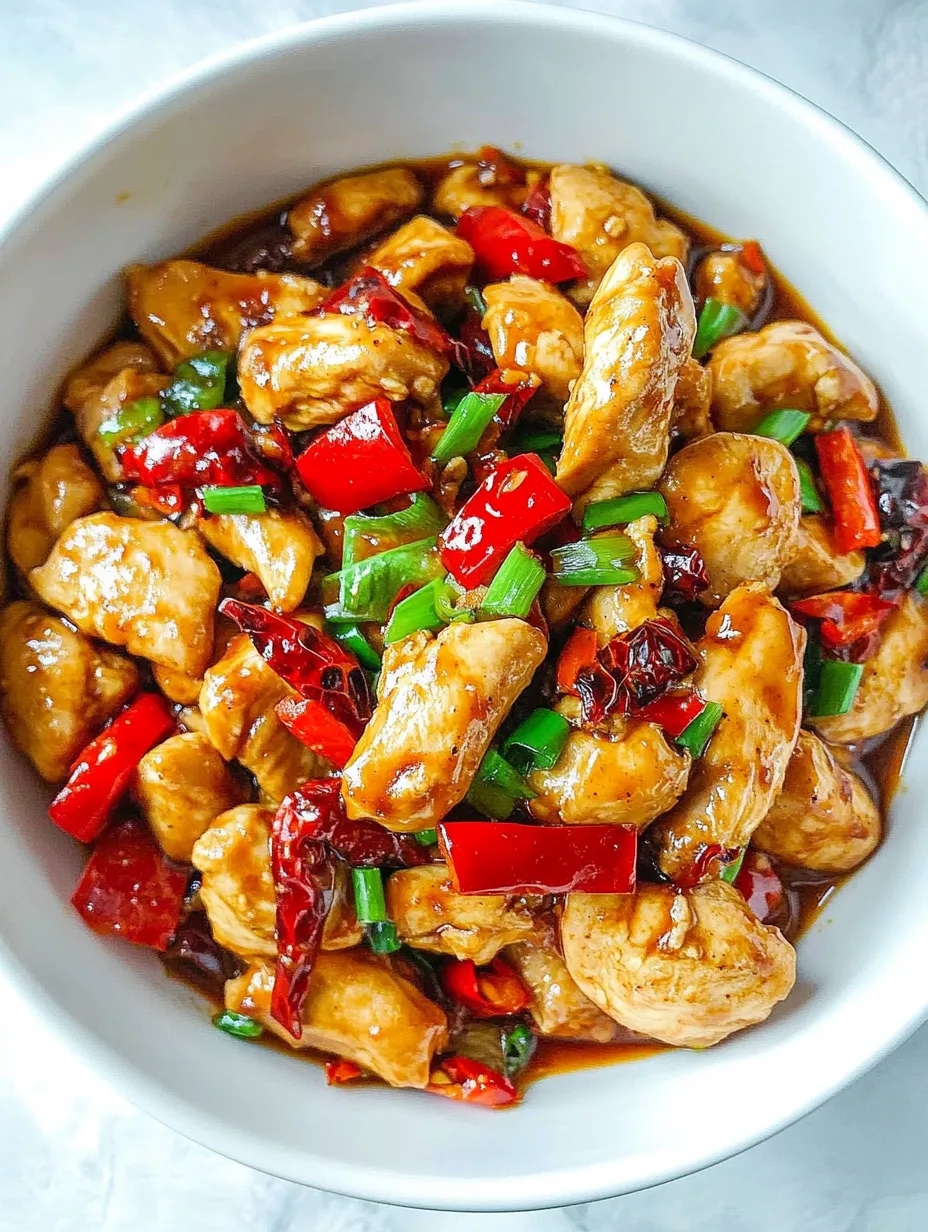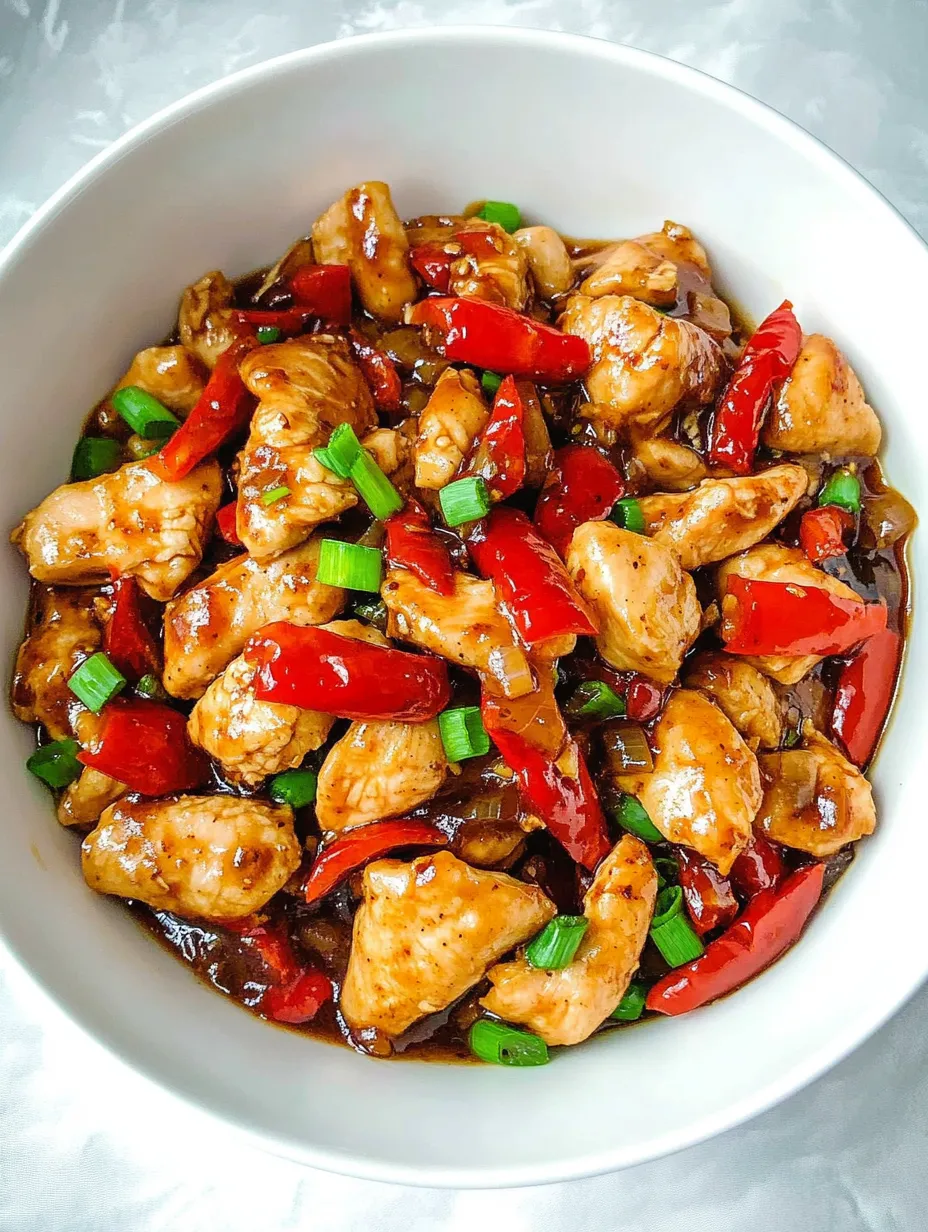 Pin it
Pin it
Tender bites of juicy chicken tossed with crisp bell peppers and onions in a rich, peppery sauce that delivers both heat and depth. This Spicy Pepper Chicken brings together four different types of pepper for a flavor explosion that transforms an ordinary weeknight dinner into something truly special. The numbing quality of Sichuan peppercorns works in perfect harmony with fresh chilies and black pepper to create layers of warmth without overwhelming the palate.
I made this for my family last Tuesday when time was tight between after-school activities, and everyone cleared their plates. Even my youngest, who typically avoids anything with visible peppers, asked for seconds. The fragrance alone that filled the kitchen was enough to draw everyone to the table before I even called for dinner.
Ingredients
- Boneless chicken thighs: Their natural fat content means they stay tender and juicy even with high-heat cooking. Look for pieces that have a pinkish color without any gray spots.
- Red bell pepper: Adds a sweet crunch that balances the heat. Choose ones that feel heavy for their size with tight, wrinkle-free skin.
- Onion: Creates a savory foundation and sweetens slightly when cooked. Firm onions without soft spots will give you the best texture.
- Fresh red chilies: Brings bright, sharp heat to the dish. Adjust the amount based on your spice tolerance, and remember that leaving the seeds in makes them hotter.
- Sichuan red peppercorns: The star ingredient that creates that distinctive tingling sensation. Quality matters here—look for bright reddish-pink ones that smell intensely fragrant when crushed.
- Shaoxing rice wine: Adds complexity and removes any gaminess from the meat. If buying from an Asian market, look for ones labeled "for cooking" rather than drinking varieties.
- Dark soy sauce: Primarily adds rich color and subtle sweetness. The good stuff should coat the back of a spoon like thin syrup.
- Fresh ginger and garlic: Always choose firm garlic cloves and ginger pieces that feel heavy and have smooth skin with no wrinkles or mold.
 Pin it
Pin it
Instructions
- Step 1:
- Marinate the chicken - Cut boneless chicken thighs into bite-sized pieces, roughly 1-inch cubes. Place them in a medium bowl and add grated garlic, a pinch of ground white pepper, low sodium soy sauce, a teaspoon of cornstarch, and a few drops of sesame oil. Gently mix everything with your fingers, ensuring each piece gets evenly coated. Let this sit while you prepare the other ingredients, allowing the flavors to penetrate the meat and the cornstarch to tenderize it.
- Step 2:
- Prepare your aromatics and vegetables - Take a moment to organize your cooking area before proceeding. Dice your onion into chunks roughly the same size as your chicken pieces—this ensures everything cooks at the same rate. For the red bell pepper, remove the seeds and white membrane before cutting into similar-sized pieces. Mince three cloves of garlic finely, and rough chop about an inch of fresh ginger. For the red chilies, remove the stems and slice them thinly if you want distributed heat, or chop them coarsely if you prefer occasional bursts of spiciness.
- Step 3:
- Toast and grind the Sichuan peppercorns - This step makes all the difference in developing authentic flavor. Heat a dry wok or skillet over medium heat until you can feel warmth radiating when you hold your hand above it. Add about two teaspoons of Sichuan peppercorns and shake the pan continuously for about 30 seconds until they become fragrant—you'll notice an almost citrusy, woody aroma. Immediately transfer them to a mortar and pestle or spice grinder to prevent burning. Grind them into a fine powder, checking for and removing any black seeds or twigs which can taste bitter.
- Step 4:
- Mix the stir-fry sauce - In a small bowl, combine one tablespoon of the freshly ground Sichuan peppercorns, two tablespoons of Shaoxing rice wine, one tablespoon low sodium soy sauce, one teaspoon dark soy sauce for color, half a teaspoon of freshly cracked black pepper, a teaspoon of Chinkiang vinegar, a tablespoon of sugar, and a quarter cup of water. Stir until the sugar dissolves completely. This balanced sauce will coat your ingredients with just the right amount of flavor—not too salty or sweet, with layers of peppery complexity.
- Step 5:
- Cook the dried red chilies - Heat your wok until wisps of smoke begin to rise, then add two tablespoons of oil. Once the oil shimmers, carefully add the dried Thai chilies and stir-fry for about 10 seconds until they darken slightly and become fragrant. Using a slotted spoon, transfer them to a paper towel-lined plate. This quick frying releases their essential oils without burning them, which would make the dish bitter rather than pleasantly spicy.
- Step 6:
- Cook the chicken - Without washing the wok, add another tablespoon of oil and let it heat until it's nearly smoking. Add your marinated chicken pieces in a single layer and let them sear undisturbed for about 30 seconds to develop some color. Then stir-fry for another 2-3 minutes until the exterior is golden and the inside is just cooked through. If your wok isn't large enough, do this in batches to prevent overcrowding, which would steam rather than sear the meat. Once cooked, transfer to a clean bowl.
- Step 7:
- Stir-fry the vegetables and aromatics - Add the final tablespoon of oil to your wok. Once hot, add the diced onion and the white parts of the spring onions. Stir-fry for about a minute until the onion starts to soften and become translucent around the edges. Add the minced garlic, chopped ginger, and fresh red chilies, and continue stir-frying for another 30 seconds until the kitchen fills with their aromatic scent. Be careful not to let the garlic brown, as it can quickly become bitter.
- Step 8:
- Combine everything and finish the dish - Add the bell pepper and fried dried chilies to the wok, tossing everything together for about a minute. The bell pepper should retain some crispness. Pour in the prepared sauce around the sides of the wok rather than directly onto the hot center. Return the chicken to the wok and stir-fry continuously for another minute, making sure everything gets evenly coated as the sauce bubbles and thickens slightly. Finally, add most of the green parts of the spring onions, saving some for garnish, and give everything a final toss.
The Perfect Heat Balance
The magic of this dish lies in its layered approach to spiciness. Unlike dishes that rely solely on chili heat, this recipe builds complexity through different types of peppers. The white pepper in the marinade infuses the chicken with a subtle warmth that builds from within. The Sichuan peppercorns contribute their unique numbing quality—a sensation the Chinese call "ma"—that dances on your tongue between bites. Fresh chilies provide immediate, bright heat, while the black pepper adds familiar pungency.
This combination creates what Chinese cooking philosophy considers balance—no single flavor dominates, but rather each contributes to a harmonious whole. The slight sweetness from the onions and bell peppers, along with the sugar in the sauce, tempers the heat and makes it approachable rather than overwhelming.
 Pin it
Pin it
Regional Variations
This Spicy Pepper Chicken draws inspiration from several Chinese regional cuisines. The liberal use of fresh chilies and dried red chilies is reminiscent of Hunan cooking, known for its straightforward heat. The Sichuan peppercorns obviously nod to Sichuan province's famous numbing-spicy flavor profile. However, the balanced sauce with its touches of sweetness and vinegar reflects influences from eastern Chinese cooking styles.
In Sichuan itself, a similar dish might include doubanjiang (spicy fermented bean paste) for added complexity. In Hunan, black vinegar might feature more prominently, while in Cantonese regions, a touch more sugar would likely be added to balance the heat. This flexibility makes the dish adaptive to personal preferences while maintaining its essential character.
I've always found the Sichuan peppercorns to be the most fascinating ingredient in my pantry. The first time I tried them, I was startled by the tingling sensation they produced—almost like a mild electric current running across my tongue. Now I keep them in a special airtight container to preserve their potency and find myself reaching for them whenever a dish needs that special something beyond just heat.
Every time I make this dish, I'm reminded of why stir-frying became my favorite cooking method. There's something almost meditative about the preparation—the methodical cutting of ingredients into precise pieces, the organization of components in small bowls around the stove, and then the exhilarating dance of heat, movement, and transformation that happens in mere minutes. This Spicy Pepper Chicken might look humble on the plate, but the depth of flavor it delivers makes it a dish I return to again and again, each time appreciating the beautiful simplicity of well-executed Chinese home cooking.
Frequently Asked Questions
- → Can I make this dish less spicy?
- Yes! Use fewer chilies or remove the seeds. You can also reduce the amount of Sichuan peppercorns or substitute with more black pepper for a different heat profile.
- → What can I substitute for Sichuan peppercorns?
- If you can't find Sichuan peppercorns, use more freshly cracked black pepper to make a black pepper chicken stir-fry instead. The flavor will be different but still delicious.
- → Can I use chicken breast instead of thighs?
- Absolutely! Chicken breast works well too. Just be careful not to overcook it as it can dry out more quickly than thighs.
- → How can I make this recipe vegetarian?
- Replace the chicken with pan-fried firm tofu cubes and use vegetarian oyster sauce (made from mushrooms) instead of regular oyster sauce.
- → What vegetables can I add to this stir-fry?
- This recipe is very flexible! Try adding broccoli, snap peas, carrots, celery, or any stir-fry friendly vegetables you enjoy.
